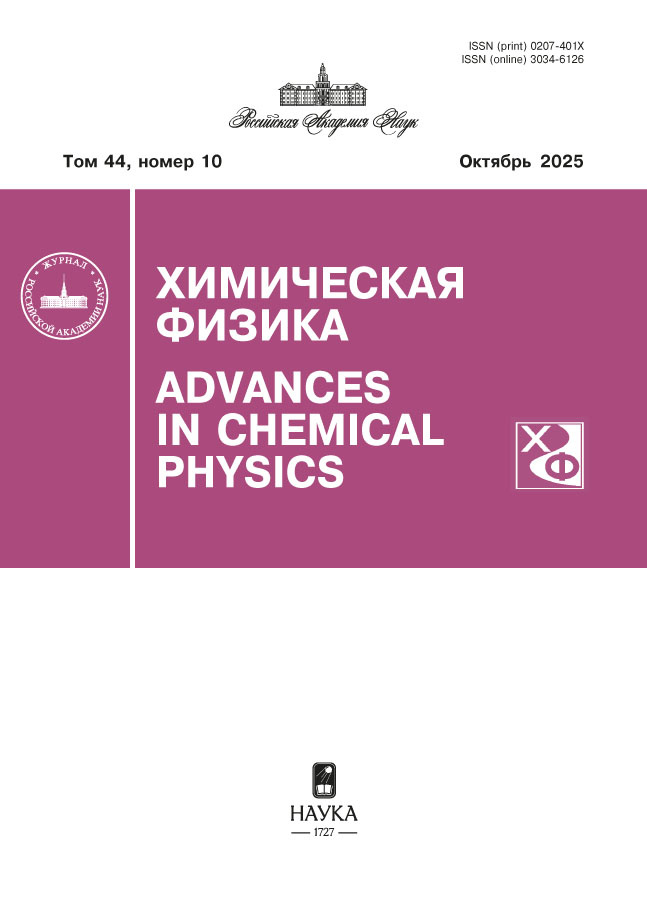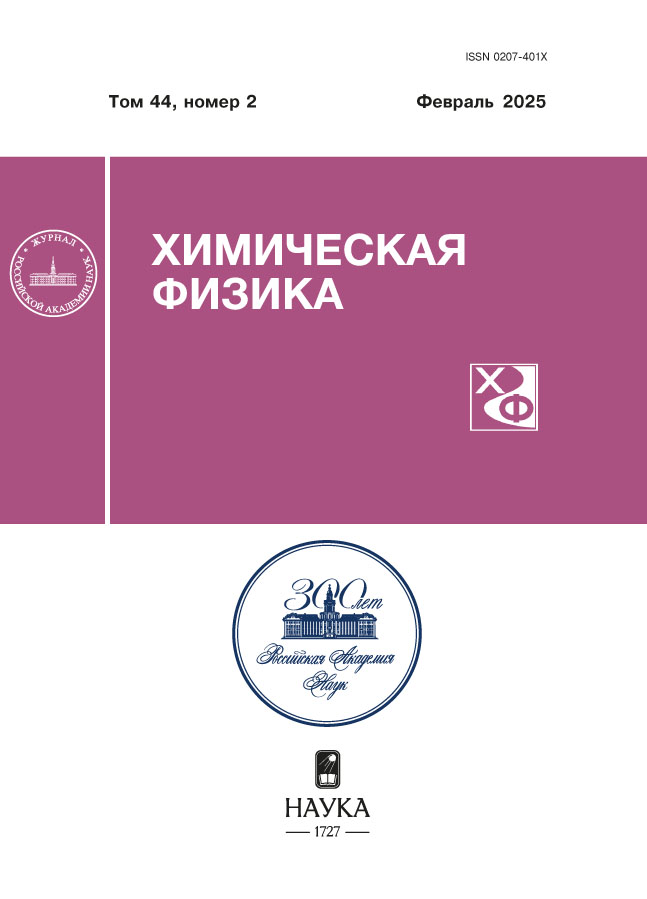Том 44, № 2 (2025)
Влияние внешних факторов на физико-химические превращения
Особенности механизма коррозии сталей в потоке раствора кислоты, содержащего соль железа (III)
Аннотация
Рассмотрены термодинамические и кинетические аспекты коррозии низкоуглеродистых сталей в потоке раствора H2SO4, содержащего Fe2(SO4)3, включая среды ингибированные смесью четвертичной аммониевой соли и KI, протекающей путем параллельного взаимодействия металла с кислотой и солью Fe(III). Потенциометрические исследования раствора H2SO4, содержащего соли Fe(III) и Fe(II), показали, что катионы Fe(III) в этих средах связаны в комплексы с сульфат–анионами, что снижает их окислительные свойства. Вольтамперные исследования поведения стали в потоке раствора H2SO4, содержащего Fe2(SO4)3, указывают на то, что коррозия включает реакцию анодной ионизации железа, протекающую в кинетической области, и две катодные парциальные реакции − выделение водорода и восстановление катионов Fe(III) до Fe(II), которые характеризуются, соответственно, кинетическим и диффузионным контролем. Последняя реакция, протекающая с диффузионным контролем, определяет чувствительность всего коррозионного процесса к гидродинамическим параметрам агрессивной среды и концентрации в ней Fe2(SO4)3. Исследована зависимость скорости коррозии стали от частоты вращения пропеллерной мешалки, используемой для перемешивания раствора. Слабое торможение смесевым ингибитором коррозии стали в растворах H2SO4, содержащих Fe2(SO4)3, – результат ускоряющего воздействия катионов Fe(III) на три парциальные электродные реакции железа.
 3-21
3-21


Кинетика и механизм химических реакций, катализ
Влияние концентрации моногидрата п-толуолсульфокислоты на реакцию метоксикарбонилирования циклогексена
Аннотация
С учетом данных о связывании воды в стабильные гидраты уксусной кислоты предложена интерпретация зависимости скорости реакции метоксикарбонилирования циклогексена, катализируемой системой Pd(OAc)2 – PPh3 – моногидрат п-толуолсульфокислоты, от концентрации последнего компонента. Схема механизма этой реакции дополнена реакцией образования устойчивых гидратов уксусной кислоты AcOH ∙ (H2O)n, где n = 1–10. Оценена эффективная константа скорости метоксикарбонилирования циклогексена. Сделан вывод о возможности образования устойчивых гидратов уксусной кислоты в присутствии небольших количеств воды в среде толуола.
 22-31
22-31


Горение, взрыв и ударные волны
Самораспространяющийся высокотемпературный синтез высокоэнтропийных карбидов и боридов: особенности горения
Аннотация
В последнее время появляются работы, посвященные получению и исследованию высокоэнтропийной керамики, в частности высокоэнтропийных карбидов и боридов. Предполагается, что свойства ВЭК благодаря искаженности кристаллической структуры будут превосходить свойства одно- или двухкомпонентных боридов и карбидов. В работе исследовано влияние соотношения компонентов и поджатия образцов на скорость их горения и удлинение, морфологию и фазовый состав продуктов синтеза в системе х(Ti+Hf+Zr+Nb+Ta+5С)+(1 – х)(Ti+Hf+Zr+Nb+Ta+10В). С увеличением в составе смесей содержания бора, скорость горения образцов возрастала. Обнаружено существенное влияние примесного газовыделения на процесс горения образцов. Скорость горения поджатых образцов значительно возросла. Удлинение образцов возрастало при увеличении содержания углерода в составе смеси. Из-за значительного удлинения продукты синтеза обладали высокой пористостью, из них легко получались порошки. Методом ренгенофазового анализа в составе продуктов горения смеси Ti+Hf+Zr+Nb+Ta+10B зафиксированы рефлексы высокоэнтропийного диборида [Ti, Hf, Zr, Nb, Ta]B2. В составе продуктов синтеза смеси Ti+Hf+Zr+Nb+Ta+5C идентифицированы три многоэлементных карбида: средне энтропийный [Ti, Hf, Ta]С и два высокоэнтропийных – [Ti, Hf, Zr, Ta]С и [Ti, Hf, Zr, Nb,Ta]С. Продукты горения смеси 50%(Ti+Hf+ +Zr+Nb+Ta+5C)+50%(Ti+Hf+Zr+Nb+Ta+10B) содержат в составе пять многоэлементных высокоэнтропийных фаз: два диборида и три карбида на основе твердых растворов металлов. В данной работе впервые методом самораспространяющегося высокотемпературного синтеза (СВС) получена высокоэнторопийная керамика, содержащая в составе высокоэнтропийные карбиды и бориды. Метод СВС позволяет осуществлять синтез в одну стадию, варьируя состав продуктов. Результаты работы могут быть использованы при получении высокоэнтропийной керамики в системе х(Ti+Hf+Zr+Nb+Ta+5С)+(1 - х)(Ti+Hf+Zr+Nb+Ta+10В).
 32-41
32-41


Экспериментальное выявление особенностей распространения волн горения 2-го рода в конденсированных средах на примере системы Ti–C2H2O4
Аннотация
Проведено комплексное экспериментальное исследование особенностей распространения волн горения 2-го рода на примере системы Ti–C2H2O4. Определены температуры самораспространяющегося высокотемпературного синтеза (СВС), скорости, тепловые эффекты, пределы горения, фазовый и химический состав продуктов. На основании полученных данных вычислены температура и глубина (полнота) превращения на поверхности горения. Обнаружено, что порошковая смесь титана со щавелевой кислотой способна гореть в широком интервале концентраций компонентов: 2–19 моль титана/моль кислоты. Выявлены два режима распространения волн горения 2-го рода: при содержании титана от 2 до 4 моль/моль щавелевой кислоты – дискретный, послойный, а при содержании титана >4 моль – фронтальный. Во всей проведенной серии экспериментов однофазными оказались лишь продукты, соответствующие составам исходных смесей 5Ti + С2Н2О4 и 6Ti + С2Н2О4. Показано, что в продуктах реакции оксалаты титана вида TiC2O4 и Ti2(C2O4)3 отсутствуют. Подтверждена возможность осуществления СВС в условиях, при которых скорости, температуры горения и тепловые эффекты реакции не будут симбатны между собой относительно их концентрационной зависимости.
 42-53
42-53


Энергетические возможности некоторых солей пентазола в качестве компонентов модельных смесевых твердых топлив
Аннотация
Изучены энергетические возможности пяти солей пентазола в качестве наполнителей смесевых твердых топлив. Показано, что только пентазолат гидроксиламмония (IV) можно считать относительно неплохим компонентом для создания модельных смесевых твердых топлив. Соединение IV превосходит октоген по величине эффективного импульса Ief (3) как в бинарном составе с активным связующим, так и в аналогичных композициях с добавкой ПХА, АДНА или Al. Пентазолаты лития, аммония, гидразиния и 1,4,5-триаминотетразолия уступают октогену в качестве основного компонента смесевых твердых топлив.
 54-62
54-62


Динамика и глубина конверсии водяного пара в водород при сгорании ансамбля наночастиц алюминия в водяном паре
Аннотация
В работе приводятся результаты численного моделирования процесса наработки водорода при сгорании ансамбля наночастиц алюминия в парах воды. В расчетах предполагалось, что конфигурация оксидного покрытия на наночастицах алюминия при температуре плавления оксида и выше является наиболее выгодной с термодинамическикой точки зрения (оксидная “шапка”). Проведенные численные эксперименты выявили влияние на глубину конверсии водяного пара в водород размеров частиц алюминия, стехиометрии реагентов, а также массовой доли оксидного покрытия. Найдено, что, несмотря на выраженную экзотермичность и сопутствующие высокие температуры (T ≈ 3000 K и выше), рассматриваемый процесс обеспечивает значительную глубину конверсии водяного пара в водород. При этом оксидное покрытие в начальный момент времени горения достаточно слабо влияет на выход водорода, а скорость процесса сгорания хотя и уменьшается с увеличением массовой доли оксида в системе в начальный момент времени, но также не слишком выражено.
 63-72
63-72


Температурная зависимость выхода продуктов холоднопламенного окисления пропана в области отрицательного температурного коэффициента
Аннотация
Экспериментально показана возможность холоднопламенного режима окисления пропан-кислородных смесей C3H8:О2 в соотношении от 1:3 до 1:1, который сопровождается проявлением области отрицательного температурного коэффициента (ОТК) скорости реакции. Повышение соотношения C3H8:О2 (обогащение смеси пропаном) приводит к расширению диапазона температур существования холоднопламенного режима окисления и смещает область ОТК в сторону более высоких температур. Холоднопламенное окисление пропана сопровождается образованием ряда востребованных нефтехимических продуктов (олефинов, оксигенатов, оксида пропилена), относительным выходом которых можно управлять путем изменения состава смеси и температуры окисления.
 73-79
73-79


Химическая физика биологических процессов
Спектральные особенности взаимодействия гемина и цинкового порфирина с гексамолибденоникелатом натрия
Аннотация
Методами электронной абсорбционной спектроскопии и спектрофлуориметрии рассмотрено взаимодействие гемина и Zn(II)-комплекса тетра(4-пиридил)порфирина (ZnТПП) с гексамолибденоникелат-анионами в водной среде. Различия в спектральном поведении двух металлопорфиринов при взаимодействии с гетерополисоединениями связаны с различиями в структуре данных порфиринов. В электронных спектрах поглощения либо проявляется трансформация полос, характерных для поглощения порфиринов, либо обнаруживаются новые полосы, свидетельствующие об образовании гибридных органо-неорганических комплексов. Для ZnТПП также наблюдается тушение флуоресценции, преимущественно статического типа, что также указывает на образование гибридных комплексов. Проведена оценка способности связывания системы ZnТПП – кристаллогидрат гексамолибденоникелата натрия (ГМН), а также оценка стабильности полученного гибридного комплекса. Результаты исследования будут полезны при создании методом молекулярного проектирования гибридных комплексов с целью дальнейшего их использования в различных медико-биологических приложениях.
 80-90
80-90


Химическая физика полимерных материалов
Формирование сорбционных пеноакриламидных композитов в условиях микроволнового нагрева
Аннотация
Представлены результаты формирования пеноакриламидных сорбционных композитов (СК) из суспензий различной природы в условиях микроволнового нагрева. Сорбционные свойства композитов увеличивали за счет дополнительного введения в матрицу пеноакриламида сорбентов неорганической (оксид марганца) и органической (хитозан) природы. Изготовление пеноакриламидных композитов на основе дисперсионных сред с химическими реагентами, реагирующими с токсичными соединениями и образующими осадки в матрице полимера, помогает увеличению сорбционной способности композитов.
 91-98
91-98


Влияние поверхностной обработки композиционных полипропиленовых волокон на их свойства
Аннотация
Методом термического разложения получены композиционные материалы, содержащие наночастицы сульфида цинка на поверхности микрогранул ультрадисперсного политетрафторэтилена. Полученные материалы использовались для модификации полипропиленовых волокон и исследовались методами рентгенофазового анализа и электронной микроскопии. Изучены их механические и антибактериальные свойства. Размеры частиц составляют от 7 до 30 нм. Нанесение модификатора делает менее заметным проявление краевых дефектов, что положительно сказывается на их механических свойствах, таких как модуль упругости и прочность при разрыве. Кроме того, модификация полипропиленовых волокон приводит к возрастанию противомикробных свойств модифицированной нити.
 99-110
99-110













